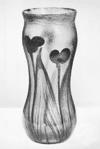- Tiffany, Louis Comfort
-
born Feb. 18, 1848, New York, N.Y., U.S.died Jan. 17, 1933, New York CityU.S. painter, craftsman, philanthropist, decorator, and designer.The son of the famous jeweler Charles Louis Tiffany (1812–1902), he studied painting with American painter George Inness and in Paris; he was a recognized painter before he began to experiment with stained glass in 1875. He founded a glassmaking factory in Queens, N.Y., in 1878. There he developed an iridescent glass he called Favrile, which achieved widespread popularity in Europe. After 1900 Tiffany's firm ventured into lamps, jewelry, pottery, and bibelots. He is internationally recognized as one of the greatest forces of the Art Nouveau style.
 Vase of Favrile glass made by Louis Comfort Tiffany, New York City, 1896; in the Victoria and ...Courtesy of the Victoria and Albert Museum, London
Vase of Favrile glass made by Louis Comfort Tiffany, New York City, 1896; in the Victoria and ...Courtesy of the Victoria and Albert Museum, London* * *
▪ American designerborn Feb. 18, 1848, New York, N.Y., U.S.died Jan. 17, 1933, New York, N.Y.American painter, craftsman, philanthropist, decorator, and designer, internationally recognized as one of the greatest forces of the Art Nouveau style, who made significant contributions to the art of glassmaking.The son of the famous jeweler Charles Lewis Tiffany, Louis studied under the American painters George Inness and Samuel Colman and also trained as a painter of narrative subjects in Paris. That he was also influenced by a visit to Morocco is evident in some of his major works. Returning to the United States, he became a recognized painter and an associate of the National Academy of Design, New York City; later he reacted against the Academy's conservatism by organizing, in 1877, with such artists as John La Farge and Augustus Saint-Gaudens, the Society of American Artists.Tiffany's experiments with stained glass, begun in 1875, led to the establishment, three years later, of his own glassmaking factory at Corona in Queens, New York City. By the 1890s he was a leading glass producer, experimenting with unique means of colouring. He became internationally famous for the glass that he named “Favrile,” a neologism from the Latin faber (“craftsman”). Favrile glass, iridescent and freely shaped, was sometimes combined with bronzelike alloys and other metals; such examples, some signed “L.C. Tiffany” or “L.C.T.,” enjoyed widespread popularity from 1890 to 1915 and were revived again in the 1960s. His Favrile glass was admired abroad, especially in central Europe, where it created a new fashion.Having established a decorating firm known as Tiffany Glass and Decorating Company, which served wealthy New Yorkers, Tiffany was commissioned by President Chester A. Arthur to redecorate the reception rooms at the White House, Washington, D.C., for which he created the great stained-glass screen in the entrance hall. He designed the chapel for the World's Columbian Exposition (1893) in Chicago and the high altar in the Cathedral of St. John the Divine, New York City.Overwhelmed by the glass display of the brilliant French Art Nouveau designer Émile Gallé at the Paris Exhibition of 1889, Tiffany became interested in blown glass. From 1896 to 1900 he produced a vast amount of exquisite Favrile glass, many pieces achieving mysterious and impressionistic effects; his innovations made him a leader of the Art Nouveau movement.Tiffany's firm was reorganized as Tiffany Studios in 1900, after which he ventured into lamps, jewelry, pottery, and bibelots. In 1911 he created one of his major achievements—a gargantuan glass curtain for the Palacio de Bellas Artes, Mexico City. Like his father, Louis was a chevalier of the Legion of Honour; he also became an honorary member of the National Society of Fine Arts (Paris) and of the Imperial Society of Fine Arts (Tokyo). In 1919 he established the Louis Comfort Tiffany Foundation for Art Students at his luxurious and celebrated Long Island estate (which he had designed in total), which in 1946 was sold to provide scholarship funds.* * *
Universalium. 2010.
